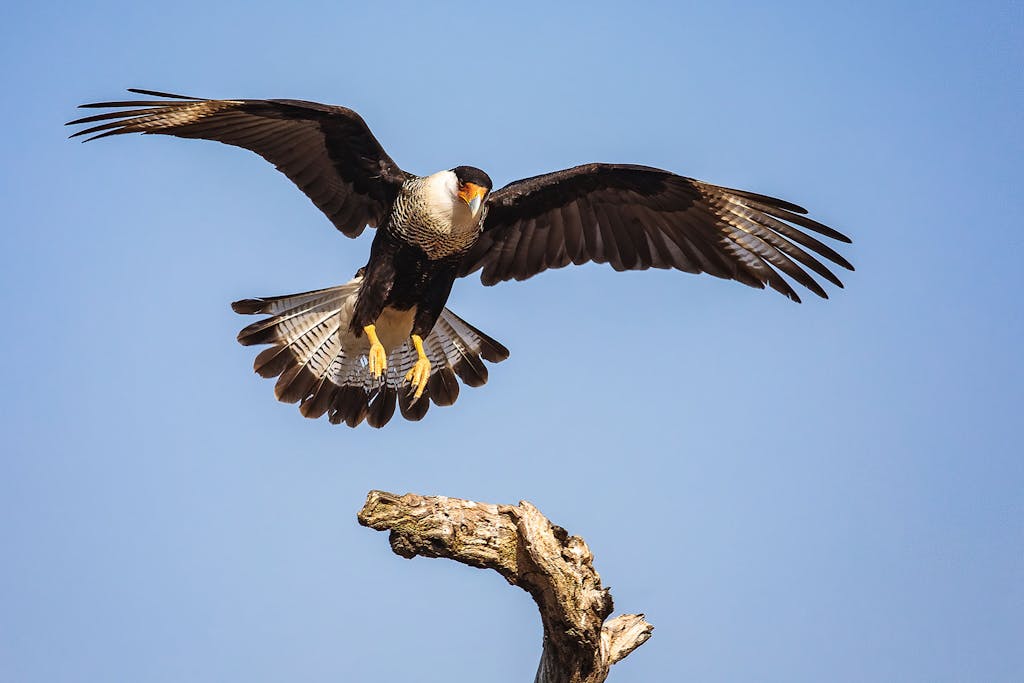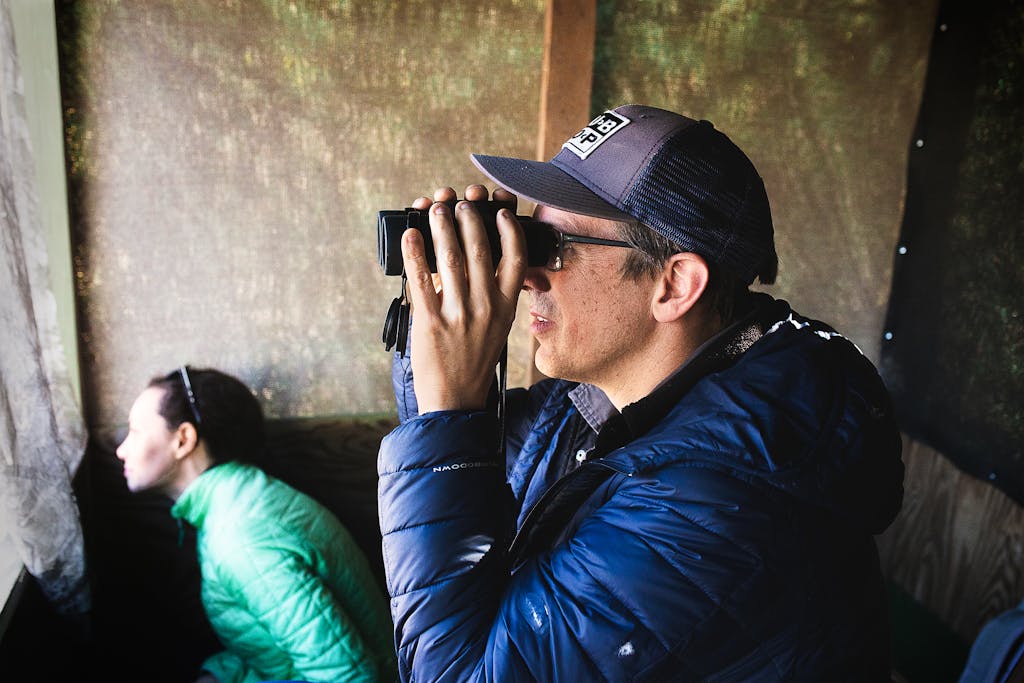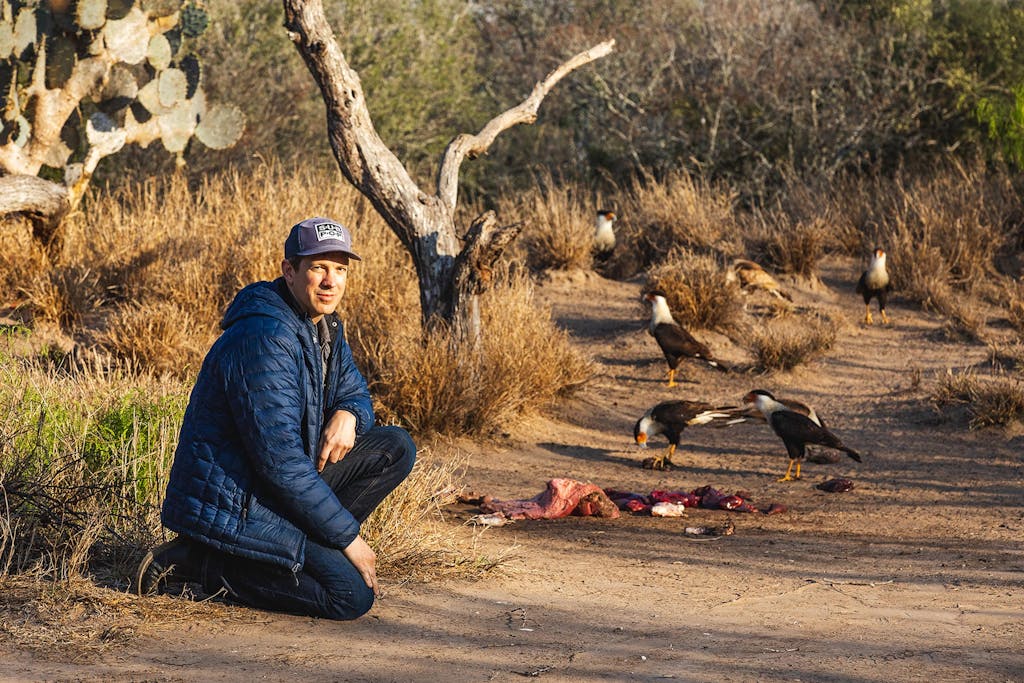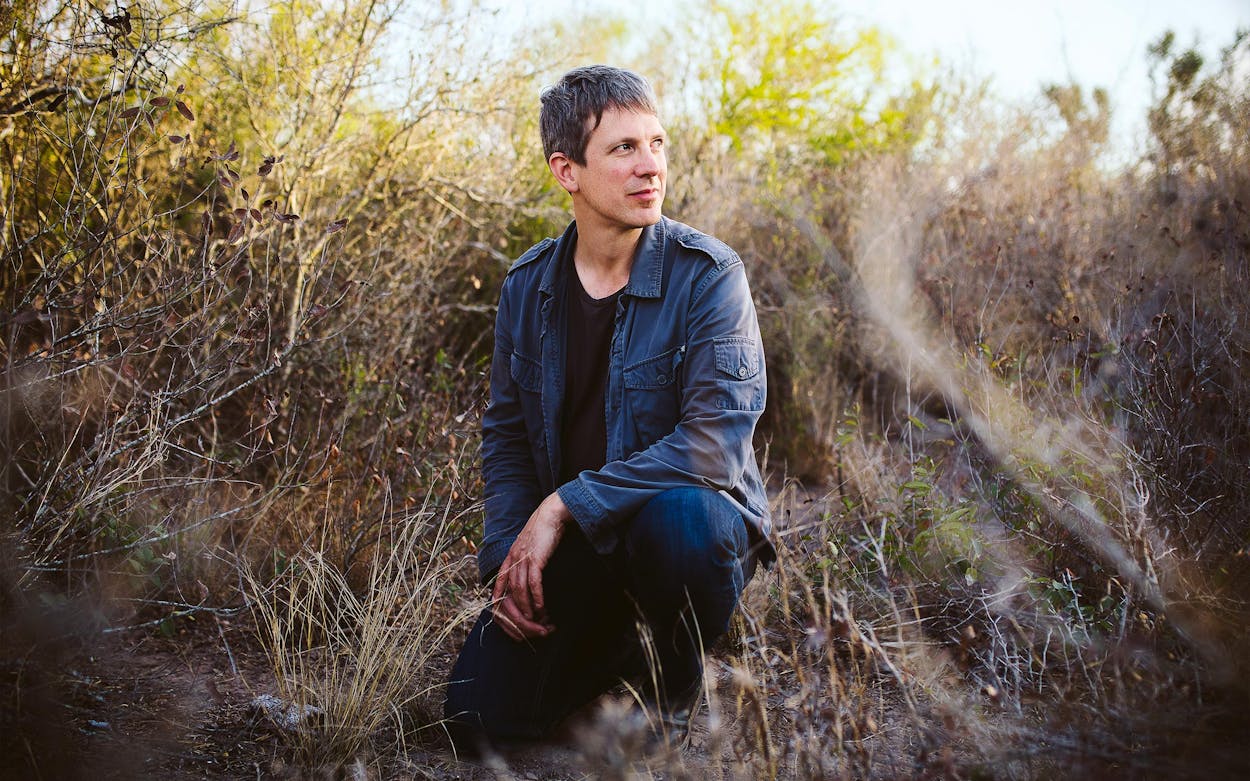Walking beneath the hazy evening sun and mesquite trees’ arching branches, Jonathan Meiburg stops along a dusty path and points up toward his left. There, a northern crested caracara ascends into the air with a powerful whoosh, propelling its black and white body forward with a series of mighty flaps before gliding gracefully to another perch farther down the trail. Meiburg turns back toward the rest of us—his partner, Jenna Moore; our guide, Patty Raney; and me—with what almost looks like a smile. His mouth slightly agape, Meiburg’s joy mixes with a serious sense of awe and fascination.
Our small party of birders scouts the blind where Raney will feed the caracaras the following morning. Around us sprawls a dense tangle of thorny brush, cacti, and scrubby trees, with an occasional verdant splash of guajillo acacia leaves. We have come almost to the edge of Texas—Mexico sits four miles to the south—to the Martin Refuge in the Rio Grande Valley to observe these birds in their natural habitat. In 1985, John and Audrey Martin purchased 180 acres of land and added a hundred more acres a year later, with the intention of conserving indigenous flora and fauna. The refuge opened to photographers eight years later; today, visitors can take guided excursions to see the wildlife that resides on the ranch, including kiskadees, green jays, rattlesnakes, coachwhips, coyotes, butterflies, and crested caracaras.
The land qualifies as an old-growth forest—a biodiverse forest more than 150 years old with limited human disturbance. It’s also one of the best places in the state to see caracaras. Here, visitors are “virtually guaranteed a lot of caracaras at close range who are used to human visitors, interacting with each other and with food, as well as black and turkey vultures and maybe a Harris’ hawk or two,” Meiburg wrote to me a few months ago. “I don’t know of anywhere else in Texas where this is possible.”
In recent years, a surge in the state’s crested caracara population has led more and more Texans to be intrigued by these large, beautiful birds, known for the recognizable cap of black feathers on their heads and their brightly hued blue and orange beaks. Meiburg, best known as the musician who has fronted the Austin indie rock band Shearwater since the late nineties, is an expert on caracaras; they were the subject of his master’s thesis in geography at UT-Austin, and he’s since spent years studying them on his own. In his new book, A Most Remarkable Creature: The Hidden Life and Epic Journey of the World’s Smartest Birds of Prey, Meiburg chronicles the evolutionary story of this curious group of falcons. While Charles Darwin was among the first to wonder how and why striated caracaras occupied only a handful of remote islands off the coast of South America, Meiburg has helped move that conversation forward, returning to it almost two hundred years after Darwin’s Beagle landed in the Falkland Islands.

Much of the world, even our immediate environment, has yet to be explained—a central idea of Meiburg’s book and something he learned by seeking out untold stories hidden in plain sight. Though he has studied caracaras for more than two decades, seeing them in the wild still inspires wonder in the seasoned ornithologist—a fascination that extends toward the way he writes about them. “All you need to enjoy the book is a vague interest in the natural world. You don’t have to be a bird person or to know anything about science,” Meiburg insists. With striking prose and talon-sharp wit, the book delivers on these lofty ambitions. After reading it, I found myself looking at birds differently, as well as the world at large and humans’ relationship to it.
Growing up with a father who worked for the newly established Environmental Protection Agency, Meiburg moved around throughout his youth, living in Maryland, North Carolina, and eventually Texas. No matter where home was, he could often be found outdoors—catching crayfish, building forts, and dreaming. “I always loved playing in the woods and having close, tactile encounters with the natural world,” he says. That early passion was cemented by an experience on St. Catherine’s Island, off the coast of Georgia. To fulfill a college science requirement, Meiburg took a field-based course investigating the ecology of the island, which made him “think more about the nonhuman world.”
His interest in caracaras stems from the same place that his book begins—two hundred miles off the coast of South America in the Falkland Islands. After Meiburg graduated from the University of the South in Sewanee, Tennessee, in 1997, he secured a Thomas J. Watson fellowship that funded him to undertake a one-year self-designed project abroad. He proposed “a survey of human life at the ends of the earth,” in which he would visit and observe remote communities around the globe—Tierra del Fuego and the Falklands in South America; an aboriginal settlement in Cape York, Australia; the Chatham Islands off the coast of New Zealand; and an Inuit settlement in the Nunavut region of far Northern Canada. A year of solo travel to isolated communities isn’t for everyone, but Meiburg loved it.“I came back from that trip with all circuits blown,” he says.
In the Falklands, a 22-year-old Meiburg helped a research team band the legs of striated caracaras, one of the ten caracara species still in existence. He was smitten by the birds’ charming behavior and surprising characteristics—they approach humans without hesitation, nipping at the zippers on backpacks as they tilt their heads inquisitively. “I met them more than half my life ago, and I’ve been chasing their story ever since,” he says. Though they’re members of the falcon family, caracaras are the slowest and poorest-sighted of the bunch, surviving more as scavengers than hunters. Like any species, they’ve adapted out of necessity.

Meiburg’s book sprang from a similar impetus. Long before he was an author, he gained renown as the creative force behind the indie rock band Shearwater (perhaps unsurprisingly, it’s named after a seabird). Meiburg founded the group in 1999 shortly before starting graduate school in Austin, where he’d moved earlier that year. In 2015, the band ran out of money in the process of making its its next album, and he found himself looking for a way to secure funds to finish it. The year prior, he had written an article about celebrated nature writer Peter Matthiessen, and had met the author’s editor in the process. Meiburg knew that authors got sizable advances for books, and he also knew he could fill a multitude of pages with his expertise on caracaras. “So often, the front door to things is closed but the side door is open,” he says. Using the funds from the advance, Shearwater was able to finish the album, Jet Plane and Oxbow, and Meiburg wrote his first book.
Meiburg decided not only to follow the genetic lineage of caracaras by combing through scholarly research, but also to personally track down all ten living species and observe them in the wild. In his book, readers cross the South American continent, meeting the central stars—island-dwelling striated caracaras—as well as mountain caracaras in the Andes and chimango caracaras in the Argentine plains. Sometimes Meiburg adopts colloquial nicknames for the birds: Johnny rooks, given to striated caracaras by European whalers of the eighteenth and nineteenth centuries, or curiquingue, the word used locally for the carunculated caracara of Colombia and Ecuador. “Just because a name is standardized doesn’t mean it’s the best one,” Meiburg says. “James Osterberg is the standardized name for that person, but Iggy Pop is obviously who it is.”
Meiburg also finds a kindred spirit in the form of nineteenth-century naturalist William Henry Hudson—a bird expert who, like Darwin, encountered and wrote about caracaras. Throughout the book, quotes from Hudson’s works inform Meiburg’s field excursions, and places Hudson lived and visited serve as geographic markers for the reader. While Darwin dismissively called caracaras “false eagles,” likening them to birds he had studied in Europe, the lesser-known Hudson grew up in Argentina and possessed a deep reverence for caracaras, which live almost exclusively in South and Central America. “With Hudson it was very much like when you discover a band that’s kind of obscure that you suddenly become obsessed with,” Meiburg laughs.
Great scientists and great musicians alike distinguish themselves by offering an insightful way of perceiving the world. Meiburg has a knack for seeing from a slightly different angle and translating his view beautifully. At the onset of the book, we feel the chilling whip of the polar winds off the tip of South America. Then we zoom out to comprehend the rotation of the Earth’s sphere in space—the cause of those winds. Meiburg, like all great nature writers, has the ability to make the world seem simultaneously gigantic and tiny. Everything is part and parcel.
A Most Remarkable Creature straddles genres, including quixotic adventures in search of rare creatures, a murder mystery that unfolds over the first third of the book, a caper of avian import and export, and an eerie expedition up a wild river in the jungles of Guyana. The book encompasses the extinction of large dinosaurs, the shifting of tectonic plates, and evolutionary genetics alongside his beloved caracaras. Meiburg’s writing throughout remains accessible, avoiding tedium and technicality.
While ostensibly “the story of a group of strange, ancient falcons, where they came from, and what the world they emerged in was like,” Meiburg’s book also has a more deeper purpose—a dissection of life on earth and our interconnectedness. As we sit in the blind on Martin Refuge in late March, he explains, “No animal exists in a vacuum.” Birds, for instance, are endemic to certain habitats. Perhaps they enjoy one kind of plant that forms seeds at one one time of year. From there, he says, “It goes beyond the present into: ‘How did things get to be this way? What was this place like in the past? How did this develop?’ It will take you all the way back to the big bang if you follow it far enough, but it can start with a sparrow.” Though Meiburg discovered striated caracaras in the Falklands, experiences that connect us to nature don’t have to come from far-flung travels. Meiburg writes about an encounter with an opossum in North Carolina when he was a young boy. And, as he writes, Hudson first fell in love with the avian fauna around his birthplace in Argentina.
Here, at the southern tip of Texas, through the curtains of the blind, we watch as Raney, the guide, walks out toward a clearing holding a large pan full of meat supplied by a local taxidermist. She has hardly made her way back to the blind before more than two dozen crested caracaras begin to tear into the meat, gripping it with curved talons and ripping it with sharp beaks. An excited caracara tosses its head back, making the dry rattling call for which the birds are known. After a while, it’s a veritable bloodbath, with the yellow legs and pale trouser feathers of one young caracara particularly stained with red. Black and turkey vultures show up to join in the feast. Watching the primal scene, I was reminded of a fact that Meiburg’s book emphasizes: birds are really just living dinosaurs.

As we watch the free-for-all, Raney and Meiburg discuss what makes South Texas different. Situated at the migratory frontier for both eastern and western birds as well as northern and southern ones, this is a rare meeting place. Moreover, North and South America were joined only recently, in the grand scheme of evolutionary time, meaning that many animals are just beginning to venture into new territories, a phenomenon covered in the book. Striated caracaras of the Falklands mark the beginning of the book, but northern crested caracaras, found right here in Texas, play a vital role in the end, portending the future of these adventurous birds.
The inside of the blind buzzes, matching the energy outside. Meiburg wears a gleeful grin as he watches the birds interact, vying for position atop a gnarled, dead tree protruding upward from a cactus patch. Moore, a biologist who studies marine worms, and Meiburg speak with hushed excitement, exchanging observations about little behavioral tendencies. The meat lasts for hours but eventually runs out. A few stragglers show up late and peck around in the dirt for scraps. One inquisitive caracara wanders over to a pile of mealworms, seeds, and peanuts that Raney put out for smaller songbirds. This is the open-minded, generalist behavior that has so fascinated ornithologists and opened up the birds to criticism from snobbish purists. Generalists risk never being good enough at one thing and may flounder for lack of confidence, but specialists can become brittle, and if things change they may not be able to adapt. Meiburg has similar woes of his own.
“I’ve worried about that in my own life; I’ve opted for being a generalist rather than being a specialist,” he confesses. “Did I do the wrong thing by not going further into hard science? Was I wasting my time trying to be a musician?” If the success of the band and the engrossing nature of this book are any indication, he didn’t, and he wasn’t. A Most Remarkable Creature, which stretches back to the dawn of all species while also giving readers a clear picture of caracaras today, is evidence of his acuity as a writer and naturalist and is a triumphant debut for an author. Likely, the public will hear more from Meiburg soon: his band is almost done with a new album, and he’s hinted at a deep interest in delving more into the icy mysteries of Antarctica.
In his music as well as his writing, Meiburg insists that everything in the world changes constantly. The book captures the epochs-long evolution of caracaras and underscores an essential truth—that places like the Rio Grande Valley or the Falklands are special, but only by virtue of their intersection with time. “One of the things I always loved about being on tour,” Meiburg explains, “was coming back home with this weird dislocated sense that where you lived was just another place.”






